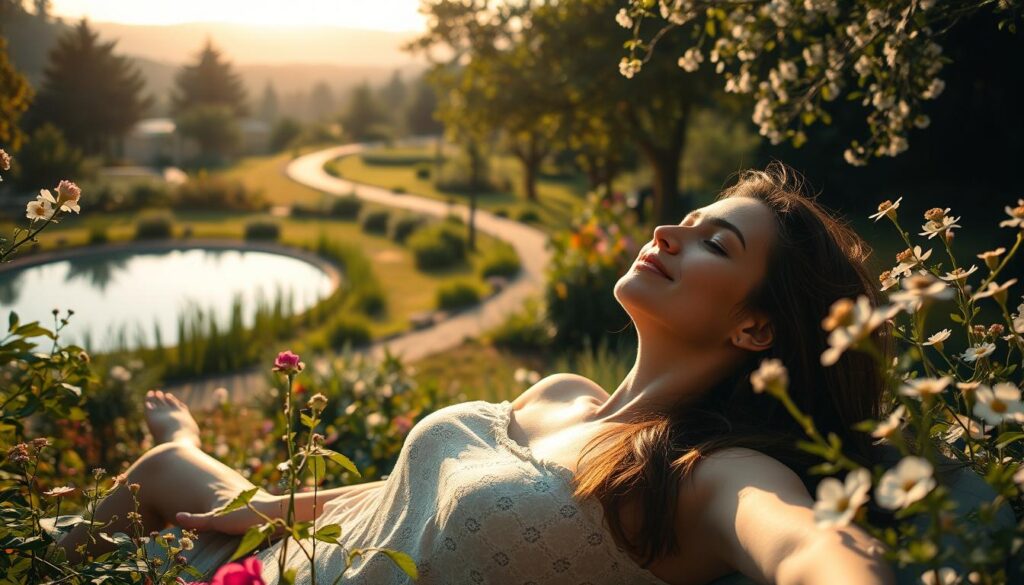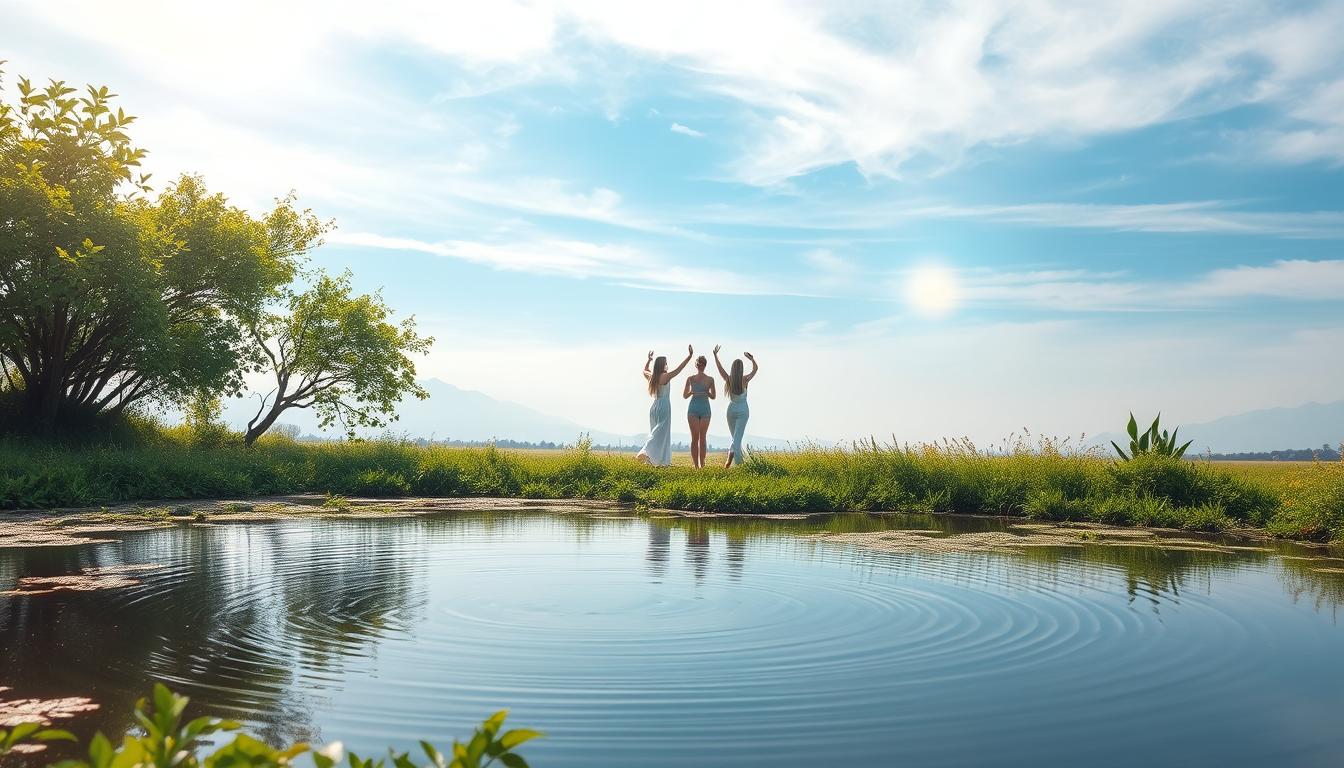Remember that moment when you enjoyed a sunset, laughed hard, or got lost in a hobby? These moments are more than breaks. They show us a deeper truth. But society often sees pleasure as something to earn or feel guilty about. What if we changed that?
For ages, thinkers like Plato and Descartes saw pleasure as a distraction. Medieval times called it sinful, and today’s work culture sees it as laziness. But science shows that pleasure shapes our memories and who we are. This pleasure journey is not just fun—it’s a path to self-discovery.
In Okinawa, the ikigai philosophy shows how small joys, like making manga, add to our long life and purpose. Psychology often focuses on struggle, missing how joy and curiosity define us. This article wants to show that seeing pleasure as wisdom, not waste, is key. It’s time to ask: What if finding joy in everyday life is the secret to living well?
Key Takeaways
- Pleasure has been historically undervalued, from ancient philosophy to modern productivity culture.
- Ikigai, rooted in Japanese tradition, links joy to longevity and fulfillment beyond material success.
- Neuroscience shows pleasurable experiences strengthen identity and creativity.
- Cultural shifts are redefining pleasure as a guide for self-expression, not guilt.
- Small daily joys, like hobbies or mindfulness, align with the principles of pleasure as a Path.
Understanding the Concept of Pleasure
Pleasure is more than just a quick joy. It’s a pleasure journey that comes from both our biology and culture. To truly enjoy mindful pleasure, we need to understand it first. It’s a feeling of fulfillment that can lead us to a more meaningful life.
What is Pleasure?
Pleasure is when our brain says we’re satisfied. It can be from watching a beautiful sunset or laughing with friends. But today, we often seek it in quick ways like eating too much sugar or scrolling endlessly. This can lead to short-term happiness but misses out on deeper pleasure exploration.
The Science Behind Pleasure
Our brains use chemicals like dopamine, serotonin, and oxytocin to feel good. But too much of these can mess with our biology. For example, eating lots of sweets can make us feel good at first but then leave us feeling empty. This can lead to more anxiety, showing us the importance of pleasure mindfulness.
The Influence of Culture on Pleasure
Culture tells us what we think is “good” joy. In the past, some thought too much pleasure was bad. Now, we’re told to always want more. But pleasure as a path means we should think for ourselves, not just follow what we’re told.
| Ancient Views | Modern Views |
|---|---|
| Epicurus: Moderation + friendship | Consumerism: “Buy more = happier” |
| Spiritual practices | Social media validation |
John Stuart Mill talked about different kinds of pleasure. He said some pleasures are more important than others. By understanding mindful pleasure and how culture and our brains work, we can see pleasure as a way to grow, not just to feel good for a moment.
Historical Perspectives on Pleasure
Our view of pleasure has changed a lot over time. This change shapes how we explore pleasure today. Both ancient wisdom and modern challenges guide us in finding pleasure as a path to happiness. This journey shows us timeless truths and changing views.
There’s a remarkable power in a person who is completely unafraid of pleasure, who knows what they love and sees themselves as fully worthy of receiving it.
Ancient Philosophies
Epicurus (341–270 BC) said true pleasure mindfulness starts with three key states. These are tranquility (ataraxia), freedom from fear, and no bodily pain (aponia). He taught a four-part cure (tetrapharmakos) to reject fear and know desire limits. His teachings were about balance, not excess.
| Desire Type | Description | Impact |
|---|---|---|
| Natural and Necessary | Basic needs like food and shelter | Easily met, foundational to well-being |
| Natural and Non-Necessary | Luxuries (gourmet foods, luxuries) | Risk overindulgence causing pain |
| Vain and Empty | Wealth, fame, status | Unlikely to deliver lasting satisfaction |
Pleasure in the Modern Era
The Protestant work ethic changed how we see leisure. Capitalism made pleasure seeking a product, linking it to work. Victorian repression and consumer culture created a mix: we’re told to seek pleasure but often feel guilty.
- Protestant ethics linked virtue to labor, not enjoyment
- Consumerism turned pleasure into a marketable ideal
- Modern stress shows the cost of neglecting finding joy in everyday life
The Shift in Understanding Pleasure Today
Today, we focus on balance in our pleasure journey. Minimalism and mindfulness bring back ancient wisdom, urging us to reject superficial desires. Studies show positive thinking improves well-being, matching Epicurus’ emphasis on inner calm. Trends like digital detoxes show a return to valuing real pleasure as a path to happiness.
The Role of Pleasure in Well-Being
For over 50 years, research has shown that pleasure is more than just fun. It’s a key to living well. By focusing on pleasure mindfulness, we learn to find joy in everyday things. Like enjoying a meal or a walk.
Studies show these moments boost our mental and physical health. Let’s dive into how pleasure impacts our well-being through science and practice.
“Pleasure deeply influences our emotional and spiritual well-being, urging us to appreciate the ordinary, find tranquility in daily routines, and cherish the minor moments that constitute our existence.”
Mental Health Benefits
Experiencing pleasure in the present moment lowers stress. It activates our calm system. Research reveals:
- Thinking about our purpose boosts joy by 50%.
- Doing things we value cuts stress by 40%.
- Enjoying small pleasures builds mental strength against anxiety and depression.
Physical Connection
Pleasure releases endorphins and oxytocin, which fight inflammation and boost our immune system. Here’s how our choices affect our health:
| Activity | Health Impact |
|---|---|
| Massage therapy | Reduces muscle tension |
| Warm baths | Enhances cardiovascular health |
| Gentle yoga | Promotes better sleep and recovery |
Pleasure as a Tool for Resilience
Life’s ups and downs test our resilience. But pleasure acts as a lifeline. Over 75% of people find strength by combining pleasure as a path with challenges. Here are some strategies:
- Practicing gratitude to stay grounded in the pleasure journey.
- Creating routines that mix purpose and joy.
By making pleasure seeking a priority, we build emotional strength. This isn’t about avoiding life’s challenges. It’s a scientifically-backed way to thrive. Every moment of joy brings us closer to being whole.
Various Dimensions of Pleasure
Starting a pleasure journey lets us see how mindful pleasure changes our lives. It touches every part of us, from our senses to our soul. Let’s dive into these layers to understand pleasure better.
Sensory Pleasures
Every day, we find pleasure in the present moment. Enjoying a meal’s texture or feeling the sun’s warmth are examples. These moments help us stay present and mindful. Jeremy Bentham’s ideas show how different pleasures, like taste and wealth, connect us to life.
- Taste: Savoring artisanal chocolates or family recipes
- Touch: A cozy blanket’s embrace or a loved one’s handshake
- Sound: Birdsong, live music, or a favorite podcast
Emotional Pleasures
Feeling connected brings us joy. Feeling proud of a project or feeling grateful are examples. Studies show that sharing laughter or kindness increases happiness. Being open and vulnerable can deepen our emotional connections, making our pleasure journey richer.
Intellectual & Spiritual Pleasures
Curiosity and spiritual quests give us lasting joy. Solving puzzles, debating, or meditating are examples. Nick Bostrom’s work highlights the difference between sensory and deeper, meaningful experiences.
| Dimension | Examples | Philosophical Roots |
|---|---|---|
| Sensory | Flavor exploration, nature walks | Aristotle’s moderation philosophy |
| Emotional | Friendship, creative collaboration | Epicurus on friendship’s value |
| Intellectual/Spiritual | Learning, spiritual rituals | Bentham’s 14 types, eudaimonia |
Exploring these areas turns pleasure into a mindful practice. Each part invites us to grow and find meaning beyond just feeling good.
Pleasure and Relationships
Building deeper connections starts with mindful pleasure. When we explore pleasure together, our bonds grow stronger. This is because activities that bond us release oxytocin and dopamine, making us feel closer.
Emily Nagoski’s emotional floor plan teaches us that safety comes first. Feeling safe is the foundation for joy in our daily lives.
Building Deeper Connections
Good communication is key in relationships. When couples seek pleasure together, they feel more satisfied. Talking openly about intimacy helps keep desires in sync.
A study found that empathy is more important than grand gestures in long-term relationships. This shows that pleasure in the present moment is more valuable than big surprises.
- Practice oxytocin-boosting acts: hugs, shared laughter, eye contact
- Use the emotional floor plan to address stress before intimacy
- Incorporate mindful touch through daily small gestures
The Role of Pleasure in Romance
Healthy sex requires mindful pleasure. Exploring ourselves and setting intimacy goals helps us understand our bodies better. This reduces stress and makes us emotionally stronger.
| Barrier | Solution |
|---|---|
| Lack of communication | Weekly “meta-conversation” check-ins |
| Body disconnect | Guided mindfulness exercises |
Social Pleasures and Community
Community bonds grow through shared pleasure exploration. Activities like festivals or helping others create a sense of unity. Serving others activates the same reward pathways as personal pleasure seeking, building a sense of belonging.
“Through service to others, we discover the profound joy that comes from making a meaningful contribution”
Even small actions, like chatting with neighbors or joining a gardening group, can bring joy. These moments show that connection is possible without big plans.
Overcoming Guilt Associated with Pleasure
Many of us feel conflicted when seeking pleasure. This is because society often sees it as selfish or unnecessary. The pleasure journey starts with recognizing how culture shapes our guilt. Cognitive dissonance happens when our desires clash with what we’ve learned.
“If you believe that your impulses toward pleasure are indulgent or a distraction from the important, meaningful aspects of life, then every time you crave enjoyment, you experience internal conflict.”

Understanding Societal Norms
Society teaches us that pleasure is a luxury, not a path to well-being. For example, 65% of those from strict backgrounds feel guilty over simple joys. Childhood shame about enjoyment lasts into adulthood for 25% of people, causing self-doubt during pleasure seeking.
To move forward, ask if your guilt comes from inside or outside rules.
Embracing Self-Care Through Mindfulness
Practice pleasure mindfulness to reconnect with what you truly need. Start with small things like enjoying a sunset or reading a chapter. Research shows self-care activities reduce guilt in 50% of people.
Ask yourself: Does this moment make me feel good? A 70% success rate in therapy shows changing thoughts can help.
Building Balance in the Pleasure Journey
Aristotle’s “golden mean” helps find balance. Track when pleasure feels good versus bad. Set boundaries for rest and goals.
Remember, finding joy in everyday life isn’t selfish—it’s essential. Small steps, like mindful breathing during coffee breaks, can change how we see enjoyment.
- Identify triggers: Note when guilt arises and why
- Challenge assumptions: Ask if rules are yours or inherited
- Start micro-pleasures: 5-minute walks or laughter breaks
By questioning societal messages and embracing pleasure as a path, we can break shame cycles. Balance isn’t about being perfect—it’s about making progress toward a fulfilling, guilt-free life.
Pleasure as a Creative Force
Embracing pleasure as a path unlocks creativity by aligning with the body’s natural energy flow. When we engage in pleasure exploration, whether through art, dance, or writing, the mind enters a state of flow. Ideas emerge effortlessly. Research shows that positive energy flow boosts innovation, transforming fear-driven routines into joyful, intuitive processes. Let’s explore how pleasure in the present moment fuels authentic creation.
“I just visualized what I wanted and gathered bits over two weeks. The process felt like a pleasure journey—no rigid plans, just trust in the flow.” — Creative practitioner
Enhancing Creativity through Pleasure
Science reveals that positive emotions broaden thinking, sparking novel connections. Try these practices to ignite your creative spark:
- Practice mindfulness to stay rooted in the present moment during creative tasks.
- Experiment with sensory-rich materials—color, sound, or texture—to engage intuitive processes.
- Set aside perfectionism. Let curiosity guide experimentation, not external validation.
Finding Joy in Artistic Expression
Artistic creation becomes a pleasure journey when focused on process over product. Studies show 70% of people feel more creative after mindful practices, while tantric techniques deepen emotional and creative resonance. Let art be a mirror of your inner world, not a performance. When we honor every step of the pleasure exploration, even “mistakes” become stepping stones to innovation.
Practical Ways to Incorporate Pleasure
Starting your pleasure as a path in daily life is easy. Just take small, thoughtful steps. Studies show that even short moments of joy, like enjoying morning coffee or a sunset walk, can make you feel better and less stressed. Here are some simple ways to add joy to your day without making it complicated.
Embrace Daily Practices for Joy
Start by finding joy in everyday moments. Set aside time for simple pleasures like journaling, cooking your favorite dish, or listening to music that brings back happy memories. Dr. Elaine Aron found that just 10 minutes of mindful tea drinking can calm your nerves. Here are some steps to follow:
- Find 3 small joys each day (like sunlight or a pet’s greeting).
- Make chores fun by dancing while you clean or listening to podcasts on your commute.
Practice Pleasure Mindfulness
Mindfulness makes small pleasures last longer. When eating, focus on the textures, smells, and tastes. This pleasure mindfulness strengthens your brain connections. Research shows that enjoying your food can make you 12% happier. Try these tips:
- Take a 30-second deep breath before starting a task to stay in the present moment.
- Write down three things you’re grateful for each week, focusing on sensory pleasures (like the smell of rain).
Create Boundaries for Joy
Setting limits helps you enjoy more pleasure seeking. Turn off your phone before dinner, have tech-free hours, or say no to things you don’t need to do. Remember, setting boundaries is not selfish—it’s essential for your pleasure journey. Think about:
- Make a “joy zone” in your home with calming scents or art.
- Use phrases like, “This is my time to recharge” to set boundaries.
By making small, consistent changes, you can turn pleasure into a lasting part of your life. Remember, “Happiness is not the absence of problems, but the presence of joy in solving them.” Begin today, and your body will appreciate it.
The Impact of Technology on Pleasure
Technology changes how we enjoy pleasure, mixing new ideas with challenges. Digital tools let us explore, connect, and create in new ways. But, we must balance them to not miss out on deeper joys.
Social media connects us but also makes us compare. Sites like Instagram and TikTok let us share our passions and find friends. But, too much scrolling can make us focus on getting likes instead of enjoying the moment. Studies link too much screen time to anxiety, as it tricks our brains into seeking constant validation.
Tools like screen-time limits help us take back control. They turn social media into a way to find happiness in everyday life, not just endless scrolling.

Gaming and virtual reality (VR) take us into new worlds of pleasure. A study at the CHI Conference found VR workouts boost motivation. Developers are using this to make healthier, more engaging tech.
But, it’s easy to get lost in the endless fun of VR, even for teens. The EU-funded EMIL project has eight guidelines for healthy VR use. They focus on well-being over constant excitement.
- Use VR to simulate outdoor adventures for those with mobility limits
- Design social features that encourage real-world interactions
- Limit reward cycles that trigger compulsive play
Technology’s impact on pleasure is complex. It can be a tool for growth if used wisely. By setting limits and valuing time offline, we can enjoy tech without losing sight of life’s simple pleasures.
Pleasure and Personal Growth
Personal growth starts where comfort ends. Pleasure exploration is more than just joy—it’s a way to find new parts of ourselves. By trying new things, we learn what’s possible. The pleasure journey shows us the way to being true to ourselves.
Feeling good is a clue to something essential in our nature.
Studies show that those who see pleasure as a path grow stronger. Here’s how it works:
- Optimal challenge zones: Activities that push us just beyond comfort zones boost growth and satisfaction.
- Pleasure mindfulness helps us tell apart short-lived pleasures from deeper desires that match our values.
- Risk-taking in safe environments fosters creativity and problem-solving skills.
| Traditional Growth Model | Pleasure-Driven Growth |
|---|---|
| Focus on struggle and sacrifice | Guided by intrinsic motivation and joy |
| Risk of burnout from relentless effort | Sustainable through positive reinforcement |
| External validation as motivator | Internal alignment with personal values |
Finding balance is important. We should avoid getting stuck by always trying new things. This makes growth fun and personal, not a duty.
Exploring Pleasure Through Travel
Travel becomes a pleasure journey when we see it as a way to explore new places. Whether we’re walking through markets or hiking trails, venturing out makes us more aware of our senses. This year, 45 million Americans are going on RV trips, showing how moving around can expand our minds.
- 62% of female solo travelers look for workshops and lessons
- 25% want adventure tours for a thrill
- GetYourGuide’s 35,000 global partners offer unique pleasure mindfulness experiences
| Category | Statistic |
|---|---|
| Bleisure travel market value | $600B USD |
| Anticipated market growth | 500% increase by 2033 |
| Solo travel interest | 40% of female travelers in 2025 |
Trying new foods or art can show us how to find more joy. For example, Paris’ culinary adventures teach us to enjoy the little things. Even short trips can change our view of the world, like the 84% of travelers who find new creativity through workshops.
Adventure travel has grown 20% globally in six years. This matches research that shows 80% of people remember joyful moments longer when they’re active. Every trip, whether a week or a weekend, is a chance to be present and mindful. With GetYourGuide’s 200M+ experiences, we can explore safely and build lasting habits of pleasure.
Future Perspectives on Pleasure
Looking ahead, the science of pleasure is blending with cultural changes. This mix will shape how we find joy. New studies show that using modern tech wisely, along with timeless values, will guide our journey of pleasure.
Key trends point to a focus on pleasure that brings meaning, not just quick happiness. This shift is important.
Shaping Societal Values Through Awareness
Stephanie Harrison’s work introduces the “New Happy” mindset, which values connection over wealth. This idea matches Aristotle’s belief that true happiness comes from finding purpose, not just fleeting joys. By practicing pleasure mindfulness, we can better control our happiness, as genetics studies suggest.
The aim is to seek pleasure that fits our personal values, not just follow trends.
Technology’s Double-Edged Role
Technology brings both benefits and challenges to seeking pleasure. Social media and VR can create illusions and distractions. But, neuroscience is helping us develop resilience against these traps.
By balancing tech use with real-life experiences, we keep pleasure rooted in genuine human connections. This is seen in the growing interest in mindfulness and community-focused lifestyles.
Adaptation as a Lifelong Practice
Embracing change means finding joy in everyday moments, as Confucius said. Harrison’s approach encourages us to ask if an activity supports our purpose. Cultivating curiosity helps us adapt to life’s changes.
Whether through travel, art, or small rituals, finding joy becomes a daily habit. The future of pleasure balances our biology and societal needs.
FAQ
What is the definition of pleasure in the context of personal development?
How does the neuroscience of pleasure influence our experiences?
In what ways do societal norms shape our understanding of pleasure?
How can historical philosophies inform modern perspectives on pleasure?
What are the psychological benefits of incorporating pleasure into our lives?
How does pleasure manifest through our sensory experiences?
What role does pleasure play in building and maintaining relationships?
How can we overcome guilt associated with seeking pleasure?
In what ways can pleasure enhance our creativity?
What practical steps can we take to integrate more pleasure into our daily lives?
How has technology impacted our relationship with pleasure?
How can adventure and travel contribute to our pleasure exploration?
What future trends might shape our understanding of pleasure?
Source Links
- Why Pleasure is a Secret Path to Self-Discovery – https://aestheticsofjoy.com/why-pleasure-is-a-secret-path-to-self-discovery/
- The true meaning of Ikigai: Discover joy & purpose in life – https://getmarlee.com/blog/what-is-ikigai
- The Pursuit of Happiness and the Pursuit of Pleasure — The Art of Meditation – https://theartofmeditation.org/burgs-blog/the-pursuit-of-happiness-and-the-pursuit-of-pleasure
- The Pleasure Trap: Why seeking the easy and comfortable life leads to more suffering — The Spivey Blog – https://www.spiveyblog.com/posts/the-pleasure-trap-why-seeking-the-easy-and-comfortable-life-leads-to-more-suffering
- Pleasure, Happiness, and the Moral Life John Stuart Mill’s Utilitarianism, Chapter 2 – The Philosophy Teaching Library – https://philolibrary.crc.nd.edu/article/pleasure-equals-happiness/
- The Source of Happiness for an Epicurean – https://www.verywellmind.com/epicurean-philosophy-and-happiness-4177914
- Why Pleasure Isn’t Always Happiness – https://racebannon.substack.com/p/why-pleasure-isnt-always-happiness
- What Role Does Pleasure Play in Happiness? – https://toddkashdan.substack.com/p/what-role-does-pleasure-play-in-happiness
- The Intersection Of Purpose And Pleasure – https://mikevardy.com/purpose-and-pleasure/
- Pleasure – https://en.wikipedia.org/wiki/Pleasure
- The Art of Living: Exploring Epicurean Philosophy and the Pursuit of Pleasure – https://www.planksip.org/the-art-of-living-exploring-epicurean-philosophy-and-the-pursuit-of-pleasure/
- What Role Does Pleasure Play in Happiness? – https://greatergood.berkeley.edu/article/item/what_role_does_pleasure_play_in_happiness
- Healing Through Pleasure: <br/>The Intersection of Sexual Wellness and Mental Health – https://balancedawakening.com/blog/healing-through-pleasure-the-intersection-of-sexual-wellness-and-mental-health
- Rediscovering Intimacy and Pleasure with Emily Nagoski – https://avivaromm.com/sexual-health-emily-nagoski/
- How to Stop Feeling Guilty for Your “Guilty Pleasures” — Sustainable Bliss | Self-Care and Intentional Living – https://www.sustainableblissco.com/journal/stop-feeling-guilty-for-guilty-pleasures
- Overcoming Overwhelming Guilt With Therapy In New York – https://advancedpsychologyinstitute.com/overwhelming-guilt-new-york/
- Shame and Guilt: How to Break Free and Reclaim Self-Worth – https://kindness-compassion-and-coaching.com/personal-growth/self-improvement/shame-and-guilt-how-to-break-free-and-reclaim-self-worth/
- The Spirituality of Sexuality: How Pleasure Becomes Sacred – https://www.anandasarita.com/blog/Spirituality-of-sexuality
- PLEASURE AS POWER — MEENA BHASIN | MUSIC, PLEASURE ACTIVISM & FEMININE EMBODIMENT – https://www.meenabhasin.com/pleasure-as-power
- Logotherapy: The Pursuit of Meaning Over Pleasure – SWEET INSTITUTE – Continuing Education for Mental Health Professionals – https://sweetinstitute.com/logotherapy-the-pursuit-of-meaning-over-pleasure/
- Pleasure: Pleasure as a Pathway: Embracing Life’s Sensory Delights – FasterCapital – https://fastercapital.com/content/Pleasure–Pleasure-as-a-Pathway–Embracing-Life-s-Sensory-Delights.html
- Prioritizing Pleasure for HSPs — Desiree S. Howell, Ph.D. – https://drdesireehowell.com/blog/prioritizing-pleasure-a-guide-for-highly-sensitive-people
- The Surprising Science Behind Self-Coaching: How Pleasure Can Fuel Your Growth – Lifestyle Lines Coaching – https://www.lifestyle-lines.com/the-surprising-science-behind-self-coaching-how-pleasure-can-fuel-your-growth/
- Technological Influences on Behavior: Insights and Implications – iMotions – https://imotions.com/blog/learning/research-fundamentals/technological-influences-on-behavior-insights-and-implications/
- Can technology turn exercise pain into pleasure? – Digital Health Technology News – https://www.healthtechdigital.com/can-technology-turn-exercise-pain-into-pleasure/
- The Never Ending Pursuit of Satisfaction: How the Brain Modulates Pleasure Seeking Behavior – https://digitalcommons.morris.umn.edu/cgi/viewcontent.cgi?article=1153&context=horizons
- The Joy of Personal Growth – https://www.psychologytoday.com/us/blog/what-doesnt-kill-us/202309/the-joy-of-personal-growth
- The Complex Path to Happiness: Balancing Pleasure with Purposeful… – https://intercoast.edu/articles/the-complex-path-to-happiness-balancing-pleasure-with-purposeful-challenges/
- Solo Travel is Climaxing: GetYourGuide Transforms the City of Love Into the “City of Self-Love” with Exclusive Self-Pleasure Masterclass and Solo-Only Travel Experiences – https://www.prnewswire.com/news-releases/solo-travel-is-climaxing-getyourguide-transforms-the-city-of-love-into-the-city-of-self-love-with-exclusive-self-pleasure-masterclass-and-solo-only-travel-experiences-302368290.html
- Bleisure Travel: The Rise Of Mixing Business With Pleasure – https://www.forbes.com/sites/rogersands/2024/07/02/bleisure-travel–the-rise-of-mixing-business-with-pleasure/
- The Path to Happiness Isn’t Lonely – https://www.psychologytoday.com/us/blog/between-cultures/202412/the-path-to-happiness-isnt-lonely
- The Only Path to Happiness — Matt Swain – https://www.mattswain.com/blog/the-only-path-to-happiness
- Happiness and the pursuit of a good and meaningful life – https://www.optimallyirrational.com/p/happiness-and-the-pursuit-of-a-good

